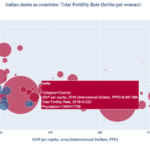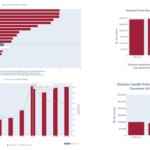Picture This: Misplaced concerns for population growth
Is a large population keeping India poor and backward and do we need China like population control measures in the country? The Uttar Pradesh government has restarted this debate in the country with its new draft bill on population control.
The picture above tries to help us answer questions about need to control population growth in the country by looking at states’ total fertility ratio (TFR) over the years. TFR of a population is the average number of children that would be born to a woman over her lifetime. According to the UN Population Division a TFR of 2.1 children per woman is considered to be replacement level TFR. It means that at a TFR of 2.1, a population would successfully replace itself without increasing or decreasing the numbers. Where does India stand?
According to the National Family Health Survey – 1 (1992-93), India had a TFR of 3.39. This came down to 2.85 in NFHS-2 (1999-99), 2.68 in NFHS-3 (2002-03), and 2.18 in NFHS-4 (2015-16). To view a state’s TFR in one of the NFHS rounds, use the slider in the top right corner and hover over the state in the India map.
Thus, India had already nearly reached replacement level TFR in 2015-16. We also observe a declining trend in India’s TFR over the years. How do states perform?
Out of 36 states and union territories covered in NFHS-4, 24 had less than replacement level TFR while 12 had a higher TFR but even these 12 states have shown a declining trend in the four rounds of NFHS till then.
What does NFHS-5 indicate? So far, NFHS-5 (2019-20) has provided us data for only 22 states and union territories. Only 3 out of these 22 states or UTs have shown a TFR higher than replacement level TFR of 2.1. In NFHS-4, 5 out of these 22 states had higher than replacement TFR. Even Bihar which had a TFR of 4 in NFHS-1 and NFHS-3, has seen its TFR decline to 3 in NFHS-5. Even in Bihar, urban Bihar has seen its TFR decline to 2.4.
When the population is growing, a country benefits from the demographic dividend. It is the economic growth which results from having larger proportion of working age population. But with a TFR of less than 2.1, which is lower than the replacement level, a country suffers the opposite. It sees a reduction in the working population which also leads to lower tax revenues, and a growing share of old population which increases the country’s healthcare costs. Thus, a TFR of 2.1 is essential for a population to sustain itself.
According to NFHS-5 data, 19 out of 22 states will see their population decline. This includes densely populated states like West Bengal and Kerala as well. As the share of older population increases, measures for population control are even more misplaced. China realising the negative social and economic effects of a one-child policy undertook a reversal of its population control measures. We need to focus our attention to serious problems like high infant and under-five mortatliy rates, maternal mortality rates and the illegal but widely prevalent sex-selective abortions.
If you wish to republish this article or use an extract or chart, please read CEDA’s republishing guidelines.







